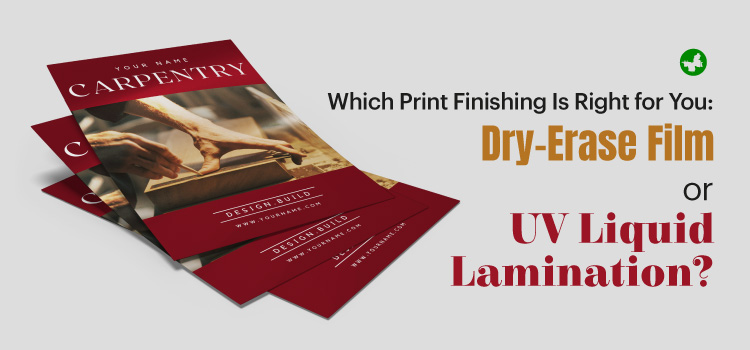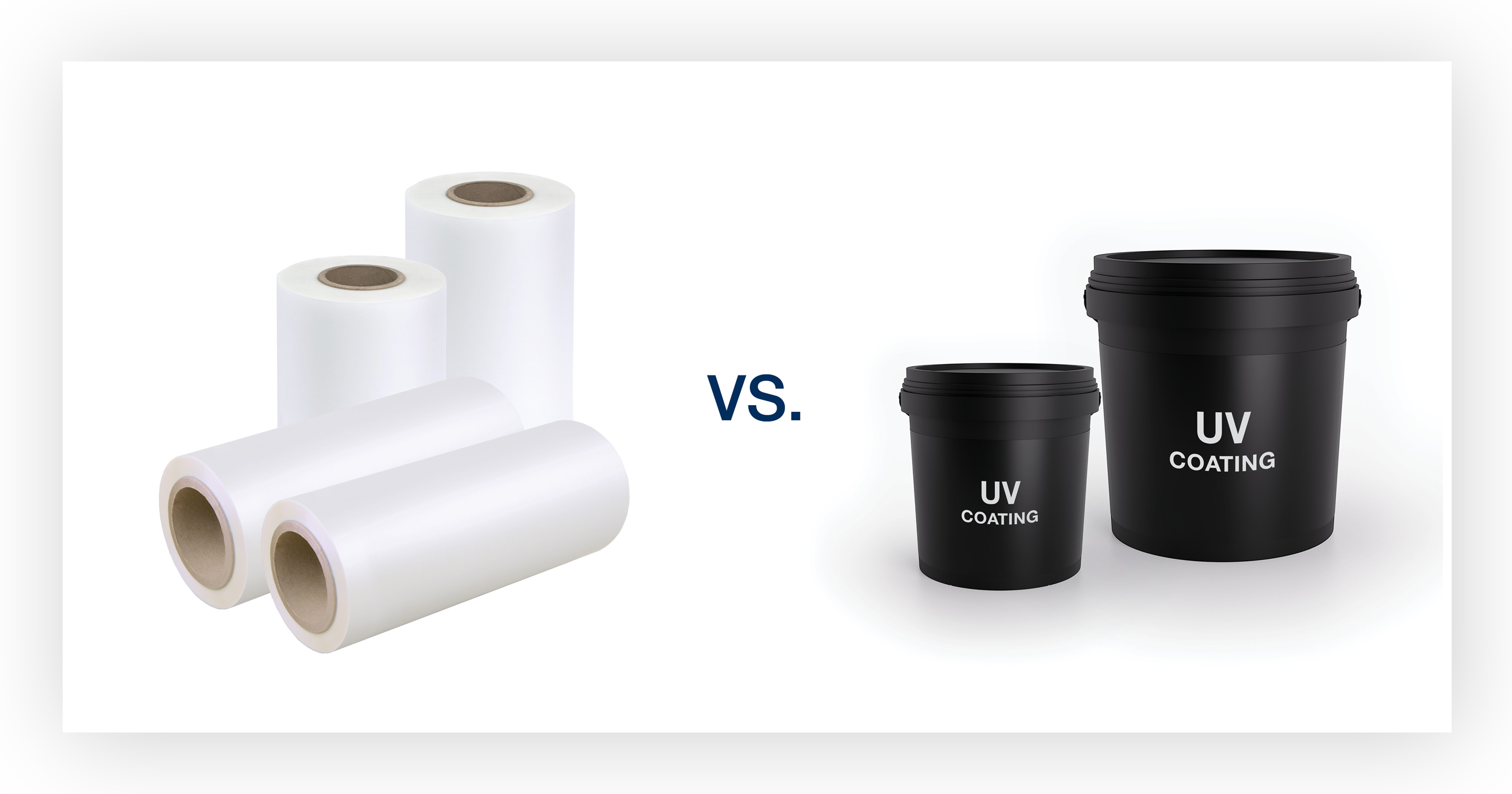UV coating is a liquid cured by ultraviolet light for a high-gloss look, while lamination is a bonded film offering superior durability and protection.

Table of Contents
What Is Lamination for Printed Materials?
What Is UV Coating in Printing?
Direct Comparison: Lamination vs. UV Coating Side-by-Side
Which Finish is Right for Your Project?
Exploring Finish Options: Gloss, Matte, and More
Making the Final Decision for Your Brand

What Is Lamination for Printed Materials?
Lamination is the process of applying a thin, transparent plastic film to the surface of a printed sheet. This film is bonded to the paper or cardstock using heat, pressure, or an adhesive, creating a permanent and protective seal. It is a robust finishing option known for significantly increasing the durability, rigidity, and lifespan of printed items. Think of it as a protective shield for your most important documents.

The primary purpose of lamination is to protect against external factors. It creates a barrier that is resistant to spills, stains, fingerprints, and moisture. This makes it an ideal choice for items that are handled frequently or used in environments where wear and tear are common, such as restaurants, hotels, and event venues.
The Process: How Lamination is Applied
There are two principal methods for applying lamination: thermal and cold. In thermal lamination, the plastic film is coated with a heat-activated adhesive. The printed sheet and the film pass through heated rollers, which melt the adhesive and apply pressure to create a strong, lasting bond. This is the most common method for commercial printing.
Cold lamination, on the other hand, uses a pressure-sensitive adhesive that does not require heat. The film and the printed material are passed through rollers that apply intense pressure to bond the two together. This method is suitable for materials that are sensitive to heat, such as certain types of vinyl or synthetic papers.
Key Benefits of Lamination
The advantages of choosing lamination are clear and substantial. The most significant benefit is its exceptional durability. Laminated items are tear-resistant and can withstand repeated handling without showing signs of wear. This process offers complete encapsulation, providing superior moisture protection and making surfaces easy to wipe clean.
Lamination also enhances the visual appeal of printed pieces. It can deepen and enrich colors, making them appear more vibrant. Furthermore, it adds a feeling of substance and quality, as the increased thickness and rigidity lend a professional, high-end feel to the final product.
Potential Drawbacks to Consider
While highly effective, lamination has a few limitations. The process is generally more expensive than UV coating, particularly for smaller print runs. The added film can also make the paper difficult to fold or score, which may require special treatment if the final piece needs to be creased. Finally, the turnaround time can be slightly longer due to the machine setup and application process involved.
What Is UV Coating in Printing?
UV coating, or ultraviolet coating, is a surface treatment where a liquid polymer is applied to a printed sheet and then instantly cured, or dried, using ultraviolet light. Unlike lamination, it does not add a separate layer of film; instead, it bonds directly to the paper, creating a very hard and resilient finish. It is primarily known for producing a dramatic, high-gloss sheen that makes images and colors pop.
This finish is a popular choice for adding visual impact to marketing materials. It can be applied to the entire sheet (known as flood UV) or to specific areas to create contrast and highlight certain design elements (known as spot UV). The coating itself is free of solvents, making it a more environmentally friendly option compared to some other varnish types.
The Curing Process: How UV Coating Works
The application of UV coating is a fast and efficient process. After the ink is printed on the paper, the liquid coating is spread across the surface. The sheet is then passed under a series of high-intensity ultraviolet lamps. The UV light triggers a photochemical reaction that hardens the liquid polymer almost instantaneously. This rapid curing process prevents the coating from seeping into the paper, ensuring it sits on the surface for maximum sheen and protection.
Primary Advantages of UV Coating
The most noticeable advantage of UV coating is its vibrant, high-gloss appearance. It delivers a level of shine that is difficult to achieve with other finishes. It also offers good abrasion and scuff resistance, protecting the underlying ink from being scratched during shipping or handling. Because the curing is instant, production times are very fast, making it an excellent option for projects with tight deadlines. From a cost perspective, it is typically more affordable than lamination, especially for large-volume print jobs.
Limitations of UV Coating
Despite its benefits, UV coating is not indestructible. It provides surface-level protection but is not waterproof and does not prevent tearing. Over time, the coating can be prone to cracking or showing fingerprints, especially on dark-colored backgrounds. It is also less flexible than lamination, so it may crack if applied over a fold or score without being properly prepared.
Direct Comparison: Lamination vs. UV Coating Side-by-Side
Understanding the core differences between these two finishes is crucial for making an informed decision. Each offers a unique set of benefits tailored to different needs and applications. The following table provides a clear, at-a-glance comparison of their most important attributes.
| Feature | Lamination | UV Coating |
|---|---|---|
| Protection Level | Highest (waterproof, tear-resistant, fully encapsulated) | Good (scuff and abrasion-resistant, not waterproof) |
| Appearance | Available in gloss, matte, and soft-touch finishes | Primarily known for a very high-gloss, wet look |
| Durability | Extremely durable; increases rigidity and thickness | Durable surface but can crack on folds |
| Cost | Higher initial cost, especially for smaller quantities | More cost-effective, particularly for large print runs |
| Turnaround Time | Slower due to the application process | Very fast due to instant UV curing |
| Best Use Cases | Menus, ID cards, book covers, frequently handled items | Postcards, brochure covers, direct mail, packaging |
Which Finish is Right for Your Project?
The ideal finish depends entirely on the intended use of the printed item. There is no single “best” choice; there is only the most appropriate choice for your specific goals, budget, and durability requirements. Analyzing how the product will be used is the most effective way to determine the right path forward.
When to Choose Lamination
Opt for lamination when maximum protection and longevity are your top priorities. It is the undisputed champion for items that will be handled extensively, exposed to moisture, or need to last for a long time. For businesses in the hospitality industry, this is often the standard.
Consider lamination for:
- Restaurant Menus: Protects against spills, food stains, and constant handling by patrons.
- Check Presenters & Inserts: Ensures these high-touch items remain clean and professional.
- ID Badges and Membership Cards: Provides the rigidity and resilience needed for daily use.
- Book Covers and Binders: Adds strength and prevents corners from bending and fraying.
For premium items like custom menu covers and guest directories, ensuring the printed inserts have a durable and appealing finish is paramount. A high-quality lamination can protect menus from spills and frequent handling, maintaining a professional look that complements the craftsmanship of a Beldturaleather holder.
When to Opt for UV Coating
Choose UV coating when your primary goal is to grab attention with a stunning visual effect on a budget. It is perfect for materials that need to make a strong first impression but do not require the intense durability of lamination. Its quick turnaround also makes it ideal for time-sensitive projects.
Consider UV coating for:
- Postcards and Direct Mail: The high gloss stands out in a mailbox and resists scuffing during transit.
- Brochure and Catalog Covers: Creates an eye-catching, premium look that invites people to open it.
- Presentation Folders: Adds a professional sheen to the exterior.
- Business Cards: Spot UV can be used to highlight a logo or name for a sophisticated, tactile effect.
Exploring Finish Options: Gloss, Matte, and More
Beyond the choice between lamination and UV coating, the specific type of finish—gloss, matte, or something more unique—plays a major role in the final look and feel of your product. Each has a distinct personality and communicates a different message about your brand.
The Look and Feel of Gloss Finishes
Gloss finishes, whether from lamination or UV coating, are shiny, reflective, and smooth. They make colors appear more saturated and vibrant. A gloss finish is energetic and modern, excellent for grabbing attention and conveying a sense of high quality. However, it can produce glare under direct light and is more likely to show fingerprints and smudges.
The Sophistication of Matte Finishes
A matte lamination offers a soft, non-reflective, and elegant look. It provides a more subdued and sophisticated feel, often perceived as more luxurious. A matte finish has a pleasant, velvety texture and is excellent at hiding fingerprints. It is a fantastic choice for brands that want to project a classic, refined image. It is important to note that matte finishes can sometimes soften the vibrancy of colors slightly.
Specialty Finishes and Textures
The world of print finishing also includes specialty options. Soft-touch or “velvet” lamination provides a unique tactile experience with a suede-like texture that is both memorable and upscale. Other options like linen or leather-textured laminations can add another layer of sensory engagement to your printed materials, aligning them even more closely with a high-end brand identity.
Making the Final Decision for Your Brand
Choosing between UV coating and lamination is a strategic decision that impacts your product’s appearance, durability, and cost. To make the best choice, weigh the key factors: the environment where the item will be used, the expected frequency of handling, your aesthetic goals, and your budget constraints.
If your printed materials must endure daily use, spills, and cleaning, the superior protection of lamination is the most practical investment. Its strength and resilience preserve the integrity of your brand’s assets for the long term. If the goal is to create a visually striking piece for short-term use or items that will be handled less, the brilliant sheen and cost-effectiveness of UV coating make it an outstanding selection. By aligning the finish with the function, you ensure your materials perform exactly as you need them to.



